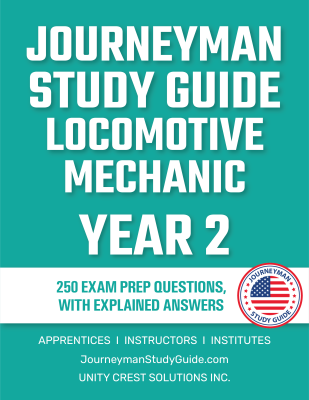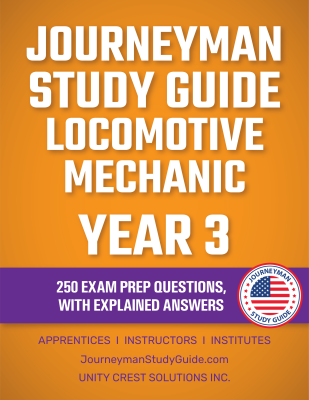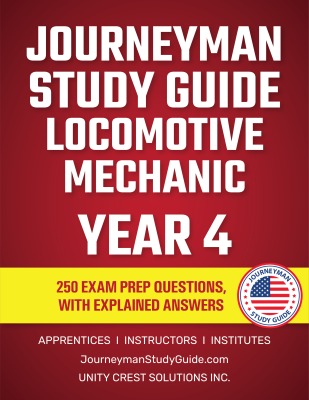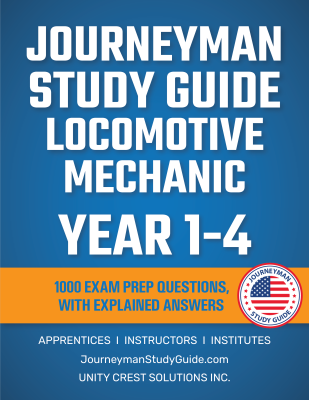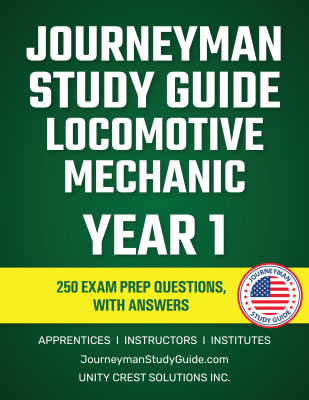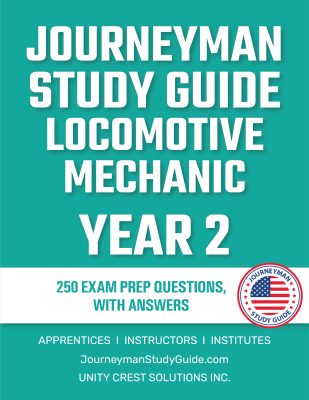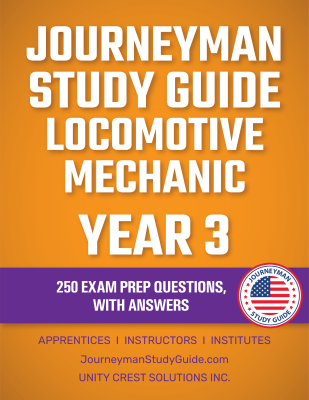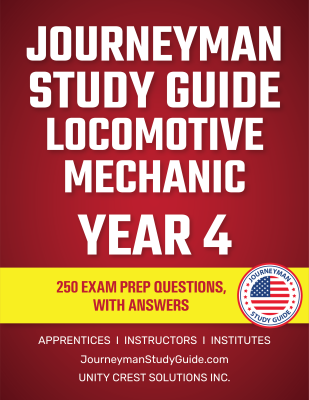Questions, Answers, & Explanations
Get clear explanations behind every answer, perfect for deeper learning and more thorough exam preparation.
Site Updates in Progress: Things might look different as we work on enhancing your experience.
What is a Locomotive Mechanic?
A locomotive mechanic is a skilled professional responsible for maintaining and repairing the mechanical systems of locomotives, ensuring they are in optimal condition for safe and efficient operation. Locomotive mechanics work on various aspects of trains, including the engines, transmission, electrical systems, braking systems, and auxiliary equipment. They are vital to the railroad industry, ensuring the smooth functioning of freight and passenger trains across the United States.
Key Responsibilities
As a locomotive mechanic, your day-to-day responsibilities can vary depending on the specific needs of the locomotive and the environment in which you work. Your duties may include:
Skills and Traits for Success
To excel as a locomotive mechanic, certain skills and traits are essential. These qualities not only help you perform your job effectively but also ensure you stay ahead in this challenging and rewarding career:
Industries Where Locomotive Mechanics Thrive
Locomotive mechanics are primarily employed within the railroad industry, but their skills are in demand in several other sectors as well. Here are some key areas where locomotive mechanics work:
Why Choose This Career?
A career as a locomotive mechanic offers numerous benefits, including:
Get Ready for Your Career in Locomotive Mechanic!
Advance your skills and industry knowledge with our Q&A guides, Q/A Explanations, and Online Tests, designed to help you master the critical concepts and pass your certification exams.
What to Expect on the Certification Exam
The certification exam for locomotive mechanics assesses a candidate's technical knowledge, hands-on skills, and understanding of the mechanical and electrical systems used in locomotives. This exam is critical for demonstrating proficiency in locomotive diagnostics, repair, and maintenance, as well as knowledge of industry standards and safety protocols.
Exam Format
The certification exam for locomotive mechanics is designed to thoroughly evaluate both theoretical knowledge and practical abilities. Here is what you can expect from the exam:
Key Topics Covered
1. Locomotive Systems & Components
A significant portion of the exam will focus on the mechanical, electrical, and hydraulic systems found in locomotives. Candidates will need to demonstrate a solid understanding of how the following systems operate:
2. Diagnostics & Troubleshooting
Locomotive mechanics need to be skilled in diagnosing issues across a variety of systems. This section of the exam assesses your ability to:
3. Maintenance & Repair Procedures
This area evaluates your knowledge of best practices for maintaining and repairing locomotives. Key concepts include:
4. Safety Standards & Protocols
Safety is paramount in the railroad industry. The exam will test your understanding of:
5. Industry Best Practices & Regulatory Compliance
You will also need to understand the latest industry trends, innovations, and best practices. This includes keeping up with:
Passing Requirements
To pass the certification exam for locomotive mechanics, most organizations require a minimum score of 70%. Achieving this score demonstrates that you possess the technical expertise and practical experience necessary to perform at a high level in the locomotive maintenance field. Some organizations may also require additional assessments or evaluations, such as practical tests or work experience verification.
Tips for Preparing Effectively
Preparation is key to success on the certification exam. Here are several strategies to help you study and perform well:
1. Study with Structured Materials
Make sure to use comprehensive and organized study materials that cover all areas of the exam. Our Q&A guides and Q/A Explanations provide a structured approach to reviewing key topics, helping you focus on the areas that are most likely to be tested.
2. Practice with Online Tests
One of the best ways to prepare is to practice with real-time, interactive online tests. These tests simulate actual exam conditions and provide immediate feedback, helping you identify areas where you may need further review. This is a great way to improve your time management skills and familiarize yourself with the exam format.
3. Gain Hands-On Experience
While studying theoretical concepts is crucial, hands-on experience is essential for locomotive mechanics. If possible, gain experience by working on actual locomotives through an apprenticeship or entry-level position. Companies like Union Pacific and BNSF Railway often offer apprenticeships that can provide valuable practical training.
4. Join Professional Networks and Unions
Consider joining professional networks like the International Association of Machinists and Aerospace Workers (IAMAW) or Brotherhood of Locomotive Engineers and Trainmen (BLET). These unions offer resources, support, and networking opportunities that can help you prepare for the certification exam and advance in your career.
Get Ready for Your Certification Exam!
Advance your locomotive mechanic career with our Q&A guides, Q/A Explanations, and Online Tests—designed to help you master critical concepts and pass your certification exams. These materials provide you with the resources you need to succeed in your exam and accelerate your career.
What Types of Questions Are on the Certification Exam?
The Locomotive Mechanic certification exam includes a variety of question formats that assess both technical knowledge and real-world problem-solving abilities. Whether you're pursuing ASE certification or preparing for internal assessments with major railroads like Union Pacific or BNSF Railway, understanding the exam question types will help you study effectively and improve your performance.
Common Question Formats
The certification exam features four primary types of questions:
1. Multiple-Choice Questions
These are straightforward questions designed to test your knowledge of:
Each question includes four possible answers, only one of which is correct.
2. Scenario-Based Questions
Scenario questions present real-world situations you might encounter on the job. For example, you might be given a malfunction report and asked how to diagnose and resolve the issue. These questions assess your decision-making and troubleshooting abilities under realistic conditions.
3. Calculation Questions
Although not overly math-heavy, the exam may include basic calculations such as:
Being familiar with tools like torque wrenches, multimeters, and calipers—as taught in vocational programs at schools like Universal Technical Institute (UTI) and Lincoln Tech—will help with this section.
4. Tool and Component Identification
You’ll be asked to recognize key locomotive components or tools. This might include:
These questions ensure that you not only understand the theory but can also apply it in a hands-on work environment like those found at Norfolk Southern or CSX Transportation maintenance yards.
Sample Questions
1. Engine Systems
Which component is responsible for mixing fuel and air in a diesel engine before combustion?
2. Brake Systems
What is the purpose of a relay valve in an air brake system?
3. Electrical Systems
Which tool is commonly used to measure electrical continuity in locomotive wiring systems?
4. Safety Protocols
According to OSHA standards, what must be done before performing maintenance on a high-voltage electrical system?
Tips for Answering Exam Questions
Read Carefully
Always read each question and all answer choices thoroughly. Key terms such as fuel injector, dynamic braking, or lockout/tagout can drastically change the meaning of the question.
Use the Process of Elimination
If you’re unsure about the correct answer, eliminate the obviously incorrect options first. This boosts your chances of selecting the correct response.
Practice Under Timed Conditions
Simulating a real exam environment using our Online Test platform is one of the most effective ways to build confidence and improve time management. Many employers like Amtrak and Wabtec also use timed exams during recruitment or promotion evaluations, so this skill will benefit you beyond the certification test.
Practice Questions for Better Preparation
Our Q&A with Explanation guide breaks down challenging exam topics into clear, digestible content. Each question comes with a detailed explanation to reinforce learning. Combine this with our interactive Online Tests, and you’ll be fully prepared for whatever format the exam takes.
These tools are modeled after real-world scenarios and question types used in locomotive mechanic assessments across the U.S., including those required by major freight rail operators and locomotive manufacturers like Progress Rail and GE Transportation.
Prepare for Your Certification Today!
Set yourself up for success with expertly designed study materials created for aspiring locomotive mechanics. Our Q&A guides, Q&A with Explanation, and Online Tests give you the edge you need to pass the certification exam and move forward in your career.
Morning: Starting the Shift and Safety Checks
A typical day for a Locomotive Mechanic begins early—often before sunrise—at a bustling rail yard or maintenance facility operated by major U.S. companies like Union Pacific, CSX Transportation, or Amtrak. The first task of the day? A thorough safety briefing and job assignment overview.
Mechanics clock in, check the day’s maintenance schedule, and review service records. Safety is top priority, so the day starts with:
At facilities affiliated with BNSF Railway or Norfolk Southern, mechanics also check for active service bulletins and manufacturer updates—particularly for GE or EMD (Electro-Motive Diesel) locomotives.
Midday: Engine Repair and Troubleshooting
By late morning, the real hands-on work begins. Mechanics dive into scheduled repairs or respond to urgent service tickets for locomotives that have been pulled from operation due to mechanical or electrical faults.
Tasks vary widely but may include:
Mechanics often work in pairs, especially when lifting or removing large components. Collaboration with electricians or machinists may also be necessary. Those employed by repair contractors like Herzog or Progress Rail might even travel between rail hubs, responding to field service calls.
Afternoon: Maintenance Logs, Testing, and Quality Checks
After lunch, the pace shifts to testing and documentation. No repair job is complete until the locomotive has been safely tested and the paperwork finalized. This part of the day typically includes:
Mechanics may also take part in preventative maintenance tasks—cleaning filters, greasing moving parts, and flushing fuel systems to extend engine life. In large facilities like those operated by Kansas City Southern, team leads perform end-of-shift reviews to track performance and plan for upcoming work orders.
Typical Work Environments
Locomotive Mechanics are found in a range of settings across the U.S., including:
Challenges and Rewards
Challenges
Rewards
Prepare for Your Career as a Locomotive Mechanic
A day in the life of a locomotive mechanic is equal parts grit, precision, and problem-solving. Whether you're aiming for your first job or moving up through the ranks, our Q&A guides, Q&A with Explanation, and Online Test are designed to prepare you for certification exams and on-the-job success.
Earning Potential
Locomotive Mechanics are well-compensated for their specialized skill set and the essential nature of their work in the U.S. transportation infrastructure. Wages vary depending on experience, union membership, and geographic location:
Union membership through organizations like the International Association of Sheet Metal, Air, Rail and Transportation Workers (SMART) or the International Brotherhood of Electrical Workers (IBEW) can significantly boost pay and benefits.
Regional Salary Differences
Demand for locomotive mechanics and wages vary by state, driven by industrial rail activity and employer presence:
Railroad mechanic jobs also tend to offer consistent overtime, adding thousands in annual earnings for those willing to work nights or weekends.
Career Growth Opportunities
Locomotive Mechanics have clear advancement pathways within the industry, both in hands-on roles and leadership positions. Career tracks often follow these progressions:
Some mechanics move laterally into engineering support, technical instruction, or rail equipment sales. Companies like Progress Rail, GE Transportation, and Wabtec offer internal training programs and long-term advancement for technicians looking to build a career.
The Benefits of Certification
While hands-on experience is crucial, certifications can give locomotive mechanics a competitive edge, especially when applying to larger employers or federal contractors.
Certified mechanics often enjoy:
Success Stories
Locomotive mechanics come from diverse backgrounds, and many find new life in the rail industry after working in related trades:
These stories highlight the long-term potential and stability available in the locomotive mechanic career path.
Advance Your Career in Locomotive Maintenance
With strong union support, competitive pay, and nationwide demand, becoming a locomotive mechanic offers long-term opportunity. Whether you're just starting out or preparing for promotion, our Q&A packs, Q&A with Explanations, and Online Test provide the exam prep you need to pass certification exams and excel on the job.
General Wage Ranges
Locomotive mechanics are in demand across the U.S. rail network, and wages reflect the importance of their role in freight and passenger transport. Whether you're starting out or advancing into a senior role, there are strong wage opportunities in this field.
Hourly wages can also be competitive, with union-backed positions ranging from $25 to $45 per hour, often with overtime and shift differential pay included.
Regional Salary Differences
Wages vary by location, reflecting the size of rail operations and regional labor costs. Here's how salaries break down across the U.S.:
Even in rural or regional locations, union-backed jobs offer reliable wage floors and strong benefit packages.
Factors That Impact Wages
Several key factors can influence how much you earn as a locomotive mechanic. Understanding and investing in these areas can lead to long-term earning potential:
1. Certifications & Technical Education
Credentials from institutions like Pennsylvania College of Technology, WyoTech, and Johnson County Community College can boost job offers and starting salaries. Railroad-specific programs teach critical systems like air brakes, diesel engines, and electronic diagnostics.
2. Industry Sector
Freight rail mechanics working with Union Pacific, Norfolk Southern, or Kansas City Southern often earn more than local transit mechanics due to the size and scope of operations. Those working in Amtrak's high-speed rail projects or Brightline in Florida also enjoy premium wages.
3. Union Membership
Joining the International Association of Machinists and Aerospace Workers (IAM) or Brotherhood of Locomotive Engineers and Trainmen (BLET) ensures collective bargaining power, better job security, and pay raises tied to experience and certifications.
4. Skill Specialization
Mechanics who specialize in electrical diagnostics, air brake systems, or EPA compliance often earn more. Diesel-electric hybrid and Tier 4 emission engine experience is particularly in demand.
Earnings by Industry
Locomotive mechanics support a variety of sectors, and pay varies by employer type and focus:
Freight rail tends to offer more overtime, while transit systems may provide more stable daytime shifts.
Opportunities for Wage Growth
Locomotive mechanics can increase their income through ongoing learning, specialization, and strategic career moves. Here’s how to boost your earnings:
1. Advanced Training & Certifications
Take additional courses in diesel emissions, digital diagnostic systems, or hydraulic troubleshooting. Look for programs through ASE, National Railroad Construction and Maintenance Association (NRCMA), or manufacturer-led certifications from Wabtec University.
2. Union & Employer Advancement
Promotion through union-supported seniority systems can bring raises and lead mechanic or supervisory positions. Positions such as Road Mechanic or Compliance Inspector often come with higher wages.
3. Relocation to High-Paying Regions
Taking a job in a large metro area or busy freight corridor—like Chicago, Los Angeles, or Dallas—can raise earnings by 10–20%.
4. Business Ownership & Consulting
Experienced mechanics sometimes branch out into independent mobile repair, fleet maintenance management, or regulatory compliance consulting for rail operators and government contractors.
Maximize Your Pay in the Rail Industry
Don’t leave your earning potential on the table. With the right training, certifications, and tools, you can climb the wage ladder quickly in this in-demand trade. Use our Q&A practice sets, Q&A with Explanations, and Online Tests to prepare for certifications and show employers your skills.
Tools Every Locomotive Mechanic Needs
Locomotive mechanics work in highly technical, industrial environments where precision and safety are paramount. The job demands a robust toolkit filled with specialized tools, diagnostic equipment, and repair machinery. Here are the essential tools every locomotive mechanic should be familiar with:
These tools are commonly found in service shops for Class I railroads like Union Pacific, BNSF, and CSX, as well as in maintenance depots across the country.
Diagnostic Technology and Modern Equipment
With the evolution of locomotive technology—especially in Tier 4 compliant engines and hybrid systems—mechanics also rely heavily on digital diagnostic platforms and computer-assisted tools:
Investing in these tools often requires specialized training, but they are essential for working with modern locomotives in the U.S. rail fleet.
Suppliers and Parts Distributors
Having the right parts and reliable suppliers is vital for quick turnarounds and safe, long-lasting repairs. U.S.-based vendors and OEMs include:
Ordering from reputable U.S. suppliers ensures parts meet AAR (Association of American Railroads) standards.
Recommended Learning and Training Resources
To get the most from your tools and develop your expertise, several top-tier training organizations and unions offer valuable resources:
Many rail shops also provide in-house apprenticeships with structured tool usage training, especially through U.S. Department of Labor Registered Apprenticeship Programs.
Budget-Friendly Tips for Building Your Toolkit
Getting started in the trade doesn’t mean breaking the bank. Here are smart strategies for building your toolkit affordably:
Why Tools and Resources Matter
In a high-pressure industry like rail maintenance, tools are more than just gear—they’re a mechanic’s livelihood. The right tools improve repair speed, boost diagnostic accuracy, and help avoid costly mistakes. By investing in proper equipment, staying current with technology, and sourcing parts from reliable American suppliers, locomotive mechanics position themselves for long-term success.
Start Building Your Career the Smart Way
Our Q&A guides, Q&A with Explanations, and Online Test are designed to help you master every tool, term, and technique you’ll need in the locomotive industry. Whether you're preparing for an apprenticeship or aiming for a lead mechanic role, we've got the study tools to keep you on track.
Where to Learn Locomotive Mechanics
If you're looking to launch a career as a locomotive mechanic, the right training is key. Across the United States, a variety of schools and training centers offer programs focused on diesel technology, rail systems, and heavy equipment maintenance. Whether you want to start in a technical college or aim for a specialized railroad training center, there are plenty of options available.
Top U.S. Training Institutions
Types of Education Programs
Certificate Programs
Certificate programs are ideal for individuals seeking to enter the field quickly. These short-term offerings—typically 6 to 12 months—focus on core skills like diesel engine repair, hydraulics, and safety protocols. Programs at Tarrant County College (TX) and WyoTech (WY) provide excellent, fast-track pathways into the industry.
Associate Degrees
Many aspiring locomotive mechanics pursue an Associate of Applied Science (AAS) in Diesel Technology. Community and technical colleges such as Ivy Tech (IN) and Texas State Technical College offer programs that blend classroom learning with hands-on repair work on diesel locomotives, generators, and air brake systems.
Railroad-Specific Apprenticeships
Some of the best training comes from within the industry itself. Railroads like Union Pacific and Norfolk Southern offer full-time paid apprenticeships that lead directly to careers as certified locomotive mechanics. These programs usually include thousands of hours of on-the-job training and classroom instruction.
What You’ll Learn in a Locomotive Mechanic Program
Programs prepare students for a wide range of tasks they'll encounter on the job, including:
How to Choose the Right Program
Accreditation and Industry Alignment
Make sure your school is recognized by regional accreditors and endorsed by industry organizations like the Association of American Railroads (AAR) or National Railroad Construction and Maintenance Association (NRCMA). These connections signal quality and industry relevance.
Hands-On Labs and Facilities
Look for programs that offer access to real locomotives, full-scale engines, and rail yards. Institutions like Lincoln Tech (with campuses in NJ and PA) provide diesel bays and advanced diagnostic labs where students can get real-world experience before entering the workforce.
Career Placement and Union Pathways
Many graduates seek placement in rail unions such as the International Association of Machinists and Aerospace Workers (IAMAW) or Sheet Metal, Air, Rail and Transportation Workers (SMART-TD). Choose a program with strong employer partnerships and apprenticeship pipelines to these unions.
Featured Programs
Ready to Level Up?
Advance your skills and prep for success with our Q&A guides, Q&A with Explanations, and Online Practice Tests—all designed to help you master the locomotive mechanic trade and earn industry credentials.
Why Join a Union or Connect with Top Employers?
For locomotive mechanics, union membership and employment with reputable rail companies provide a powerful combination of job security, top-tier wages, and career growth. In the U.S., the railroad and heavy diesel industries are heavily unionized, giving mechanics access to strong representation, benefits, and advanced training. Meanwhile, top employers in freight and passenger rail are constantly seeking certified, skilled technicians to keep their fleets running.
Benefits of Joining a Union
Better Pay and Comprehensive Benefits
Unionized locomotive mechanics consistently earn higher wages compared to their non-union counterparts. Beyond the paycheck, most union agreements include health insurance, retirement plans, paid vacation, and paid sick leave.
Job Security and Legal Protection
With a union at your side, you benefit from collective bargaining power that ensures fair treatment, proper scheduling, and due process in disciplinary matters. In volatile economic times, this protection is more valuable than ever.
Access to Advanced Training
Unions often operate their own training centers and workshops. These programs focus on the latest locomotive technologies, including computerized diagnostics, emissions control systems, and hybrid-electric drive systems.
Career Advocacy and Apprenticeships
Unions advocate for members by negotiating fair contracts, ensuring safe work environments, and opening doors to apprenticeship opportunities that lead to journeyman certification.
Top U.S. Unions for Locomotive Mechanics
International Association of Machinists and Aerospace Workers (IAMAW)
One of the largest unions representing transportation workers, IAMAW is deeply involved in rail systems across the U.S. Its Transportation Department advocates for Amtrak employees, commuter rail workers, and freight rail mechanics.
Brotherhood of Locomotive Engineers and Trainmen (BLET)
While primarily representing train operators, BLET also includes a number of mechanical craft workers. It plays a key role in national labor negotiations with Class I freight railroads.
Transportation Communications Union (TCU/IAM)
An affiliate of IAM, TCU represents rail yard workers, mechanical technicians, and Amtrak employees. It actively supports mechanical craft workers with training, legal defense, and wage negotiations.
Sheet Metal, Air, Rail, and Transportation Workers (SMART)
SMART represents a wide range of rail industry employees, including mechanical and maintenance-of-way workers. Its members work for freight companies, short-line railroads, and urban transit systems.
Connecting with Leading Employers
The railroad industry in the United States is powered by a mix of freight giants, passenger rail services, and regional carriers—all of which need qualified locomotive mechanics. Building connections with these employers is one of the fastest ways to establish a long-term, high-paying career.
Major Employers Hiring Locomotive Mechanics
Railcar Manufacturing and Maintenance Shops
Companies like Wabtec Corporation and Progress Rail (a Caterpillar company) are major employers in the rail manufacturing and maintenance sector. These firms often work in partnership with the major railroads and government transit agencies.
Tips for Finding Work in the Industry
Attend Industry Events and Job Fairs
Regional job fairs, union conferences, and industry expos like Railway Interchange provide a chance to meet employers, union reps, and fellow tradespeople. Some events even feature on-site hiring.
Complete a Recognized Apprenticeship
Many employers prefer candidates who’ve completed a structured apprenticeship through a union or railroad company. Look for programs recognized by the Department of Labor or affiliated with major railroads.
Use Union Job Boards and Placement Services
Unions like IAM and SMART operate exclusive job boards and placement programs that help members connect directly with employers. These resources often lead to better-paying jobs than public listings.
Advance Your Career Today
Get ahead in your career with our Locomotive Mechanic Q&A Guides, Q&A with Explanations, and Online Practice Tests—tools designed to help you succeed on certification exams and land top jobs in the industry.
How to Stay Ahead in the Rail Industry
The locomotive repair and maintenance field is evolving alongside modern rail technology, emissions regulations, and digital diagnostics. To succeed, locomotive mechanics must stay current with technical advancements, industry trends, and workplace best practices. As Class I railroads, regional carriers, and transit authorities invest in upgrading fleets and facilities, skilled mechanics who embrace lifelong learning will have the edge in earning potential and job security.
Emerging Trends in Locomotive Maintenance
1. Tier 4 Emissions Technology
U.S. regulations from the Environmental Protection Agency (EPA) have led to the widespread adoption of Tier 4-compliant diesel-electric locomotives, which feature advanced exhaust treatment systems. Mechanics must understand systems like Selective Catalytic Reduction (SCR) and Diesel Particulate Filters (DPFs) used by manufacturers such as Progress Rail and GE Transportation (Wabtec).
2. Locomotive Electrification
While diesel remains dominant, electrification is expanding—particularly in urban transit and commuter rail. Rail operators like Caltrain, Amtrak, and New Jersey Transit are investing in electric multiple units (EMUs) and hybrid locomotives, creating new maintenance challenges that require cross-disciplinary knowledge.
3. Remote Diagnostics & Predictive Maintenance
Class I railroads such as Union Pacific and BNSF Railway are using remote monitoring systems and predictive analytics to anticipate equipment failure before it happens. Mechanics fluent in electronic systems and software diagnostics will be in high demand.
4. Expansion of Intermodal and Freight Rail
Driven by supply chain shifts and infrastructure investment, freight rail is booming. This means more locomotive miles—and more maintenance jobs. Companies like CSX, Norfolk Southern, and Kansas City Southern are expanding technician teams across the country.
Best Practices for Career Growth
Continuing Education & Certifications
Upskilling is essential in today’s rail industry. Mechanics are encouraged to pursue training through:
Build a Specialized Portfolio
Mechanics who document experience with EMD engines, GEVO powerplants, or AC traction systems often stand out. Include case studies, rebuild reports, and digital diagnostic logs in your portfolio to show proficiency with modern systems.
Network at Industry Events
Annual gatherings like Railway Interchange, AREMA Conference, and ASLRRA Connections provide excellent opportunities to meet employers, union leaders, and manufacturers. These events often feature training seminars and job placement leads.
Join a Union for Structured Advancement
Unions such as IAMAW, SMART, and TCU/IAM offer defined paths to journeyman status, access to exclusive job boards, and industry-approved apprenticeships. Membership also provides legal support and wage protection.
Challenges and Opportunities
Current Challenges
Future Opportunities
Sustainability in Rail Maintenance
Eco-Friendly Fluids and Components
Manufacturers like Chevron and Shell Rail now produce low-emission lubricants and biodegradable hydraulic fluids that meet EPA rail compliance standards.
Energy Efficiency Retrofits
Programs like Amtrak’s Energy Efficiency Upgrades focus on retrofitting older locomotives with LED lighting, idle-reduction tech, and regenerative braking systems—providing new maintenance opportunities.
Reducing Waste and Emissions
Modern maintenance facilities are integrating closed-loop recycling systems and on-site emissions testing to meet sustainability goals. Shops using these methods often prioritize hiring mechanics with green technology experience.
Why Staying Ahead Matters
In a trade where safety, efficiency, and environmental responsibility are critical, professionals who commit to continuous growth will always be in demand. Whether you're tuning up Tier 4 engines or wiring hybrid traction systems, your adaptability will shape your value in the workforce.
Stay Competitive in the Rail Industry
Elevate your career with our Locomotive Mechanic Q&A guides, Q&A with Explanations, and Online Tests designed to help you pass certification exams and land high-paying roles.
Get clear explanations behind every answer, perfect for deeper learning and more thorough exam preparation.
Quick and easy practice to test your knowledge anytime, anywhere—ideal for simple, on-the-go preparation.


